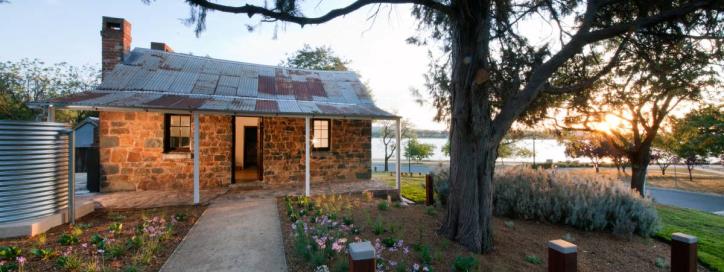Blundells Cottage
- Home
- Attractions
- Blundells Cottage

Blundells will be closed the weekend of 27 and 28 December - see you again in 2026!
Open Saturdays and Sundays 10 am – 2 pm
Entry is FREE
Location
Wendouree Drive (via Constitution Avenue), Kings Park
Parkes ACT 2600
Accessibility
There are five (5) accessible car park spaces in the car park on Wendouree Drive (via Constitution Avenue) and a wheelchair accessible path to the front of the cottage for a close view of the oldest sections of the cottage, gardens and orchard. The heritage cottage was constructed in 1860s and does not meet accessibility standards, however, the virtual tour of the inside of the cottage can be seen here.
Contact
P (02) 6272 2902
E nce@nca.gov.au
*Caution, Watch Your Step*: Blundells Cottage, the Slab Shed and surrounds’ is a heritage property and there are uneven surfaces, trip hazards and low structures so please proceed with caution and take care when visiting this heritage site.
Please note: Blundells Cottage is over 150 years old and we may need to close it from time to time in extreme weather, for your safety and that of our volunteers. We’ll keep you updated on any closures on both our Facebook page and Twitter feed.
Blundells Cottage Virtual Tour.
About the cottage
The stone dwelling, now known as Blundells Cottage, was built around 1860 to house Duntroon's head ploughman, William Ginn, and his family (1860-1874). It was then occupied by George Blundell, a Duntroon bullock driver and his family (1874-1933) and finally by shepherd Harry Oldfield and his wife Alice (1933-1958). Harry and Alice took in boarders, a tradition that Alice continued after Harry's death in 1942. This included the Sainsbury family, who lived at the cottage between 1958 and 1960.
After the last tenant vacated the cottage, the Canberra and District Historical Society (CDHS) approached the National Capital Development Commission (NCDC), for custodianship. In 1961, Sir William Holford, a British consultant town planner, wrote:
'Oldfield's cottage is a valuable relic of Canberra's early days. Encircled by trees it could well remain as an object of interest to visitors, without appearing incongruous in its new surroundings. Restored to something like its original state it would make a symbolic foil for the majesty of the Parliament House opposite'. Cited in Freeman Collett and Partners, 1995, Blundells Cottage Precinct Conservation Management Plan, ACT. Vol. 1: 29
In 1964, following its restoration, the Cottage was handed over to the CDHS, which managed it and established a museum collection. Since 1999 it has been managed by the National Capital Authority (NCA) as a house museum. It is the only pre-Federal Capital building in the National Triangle.
Quick Facts
- The Cottage was built around 1860, from stone taken from Mount Ainslie and Black Mountain
- This area of Canberra was once a rural landscape. This changed when the site was chosen for the National Capital of Australia
- When built, the Cottage was surrounded by paddocks and overlooked the Molonglo River, which was located a quarter mile (400 metres) away. It was a working smallholding, with a collection of outbuildings, haystacks, animals and farm equipment
- The Ginn family were the first to live in the Cottage, staying for about 14 years
- The Blundells lived there for about 60 years. During this time, they had 8 children and added two rooms to the Cottage to create more space for their large family
- The Sainsburys were the last family to live in the Cottage, moving in as tenants of Mrs. Oldfield and staying until 1961
- Water, gas and sewerage have never been connected to the Cottage and electricity was only connected when it became a museum
- During the 100 years that the Cottage was occupied, there were just three tenants - the Ginns, the Blundells and the Oldfields, but many different people lived there
- Due to a lack of accommodation in the young National Capital, boarders rented rooms in the Cottage. At times there were two families renting rooms from Mrs. Oldfield, with other individuals living on the front verandah (which was enclosed) and in the turkey shed.
Blundells Cottage landscape and surrounds
History
The story of this humble workers home and its landscape is a story of resilience and hard work. Once part of the Duntroon Estate, then a farmlet and rental accommodation for the early Federal Capital, residents had to be self-sufficient. They grew their own food, managed livestock and often made whatever they needed. Residents saw the Molonglo River transformed into Lake Burley Griffin, the centrepiece of the national capital. The house was occupied from 1860 until 1961.
The landscape is an interpretation of Blundells Cottage as a farmhouse set in an agricultural setting. The following elements are visible in the landscape and interpret past activities and structures.
The Fenceline
Timber fence posts installed along the northern boundary show the location of part of the original fenceline that defined the lease area for the Cottage. This lease adjoined the bullock and horse paddocks of Duntroon Estate and to stop the horses eating his crops, William Ginn, erected a fence topped with wooden spikes.
Dirt Track
The Cottage stands some distance from the original public road, known first as Church Lane and then, after a low level bridge crossing was opened on the Molonglo River in 1929, renamed Scott’s Crossing Road. The planting bed, south of the Cottage winding towards the creek, interprets the historic alignment of “The Track”, which began at the front gate on Scott’s Crossing Road and continued across the creek to the Cottage.
Vegetable Patch
In 1933 Harry and Alice Oldfield moved into Blundells Cottage and Alice supplied farm produce to public servants, residents and boarders for many years. A vegetable garden located to the north of the Slab Shed interprets Alice Oldfield’s former kitchen garden.
Potato Field
Planting beds along the western side of the cottage represent the former potato paddock that existed there in 1958 to 1961.
Former Kitchen and Fireplace
In 1888, after the birth of their eighth child, the Blundell family undertook some extensions to the cottage including an addition to the main building, an external kitchen and bread oven. Stone paving outlines the footprint of the former kitchen structure and fireplace, since demolished.
The story of Canberra doesn’t stop at Blundells; explore the significant events and extraordinary people that shaped Australia’s capital at the National Capital Exhibition. Not only is it air conditioned, but it has a great view over the calm waters of Lake Burley Griffin. A fun, relaxing and cool environment, the Exhibition is open weekdays 9 am – 5 pm and weekends 10 am – 4 pm (closed Christmas Day and Boxing Day).


- Attractions
- Events
- Education
- Planning
- Planning in the National Capital
- Works Approval
- Heritage
- Heritage Strategy
- Heritage Management Plans
- ANZAC Parade Heritage Management Plan
- Acton Complex Draft Heritage Management Plan
- Australian American Memorial and Sir Thomas Blamey Square Heritage Management Plan
- Blundells Cottage Heritage Management Plan
- Changi Chapel Heritage Management Plan
- Commencement Column Monument HMP
- General Bridges Grave Heritage Management Plan
- High Court – National Gallery Precinct HMP
- King George V Memorial Heritage Management Plan
- Lake Burley Griffin and Adjacent Lands Heritage Management Plan
- National Carillon and Aspen Island Heritage Management Plan
- National Rose Gardens Heritage Management Plan
- Old Parliament House Gardens Heritage Management Plan
- Parliament House Vista Heritage Management Plan
- State Circle Cutting Heritage Management Plan
- Surveyors Hut and Surveyors Park Heritage Management Plan
- York Park Heritage Management Plan
- Heritage Management Plans under consultation
- Heritage Management Plans previous consultations
- Consultations
- Plans, policies and guidelines
- National Capital Plan
- Heritage Management Plans
- Planning Policy Review
- Urban design
- Acton Peninsula Precinct Structure Plan
- City and Gateway Urban Design Framework
- Constitution Avenue Public Realm Handbook
- Creating Places for People and Road User Hierarchy
- Deakin Forrest Residential Precinct Guidelines
- Guidelines for Commemorative Works in the National Capital
- Guidelines for Perimeter Security in the National Capital
- Outdoor Lighting Policy
- Parliamentary Zone Review
- The Griffin Legacy
- Tree Management Policy
- West Basin Precinct Guidelines
- Yarralumla Bay Recreational Hub Master Plan
- Your Capital, Your Say
- Environment
- National Land management
- Asset management
- Lake Burley Griffin
- NCA Projects
- Current NCA Projects
- Past NCA Projects
- Anzac Parade works
- Blundells Cottage Conservation and Interpretation Project
- Boundless Playground Picnic Deck
- Boundless parking extension
- Bowen Place Crossing
- Captain Cook Memorial Jet Upgrade Works
- Car Park Upgrades
- Commonwealth Park Lighting Replacement
- Dame Dorothy Tangney and Dame Enid Lyons Sculpture
- Draft Tree Management Policy
- Dunrossil Drive Pine Tree Replacement
- Furniture upgrade in Commonwealth Park
- High Mast Lighting
- International Flag Display Extension & Lighting Upgrade
- Interpretive Signage in the National Triangle
- John Gorton Building Car Park Upgrade & Associated Works
- John Gorton Building East Car Park Car Park Lighting Replacement Works
- King George V Memorial Works
- Kings Avenue Overpass
- Kings Park Improvements
- Lake Burley Griffin Wall Renewal Program
- Landscape Renewal at the Forecourt of the National Library of Australia
- Merchant Navy War Memorial Upgrade
- National Carillon Upgrade Works
- National Gallery of Australia Foreshore Upgrade
- Old Parliament House Gardens – rose name signage
- Regatta Point Redevelopment
- Restoration Works for the National Emergency Services Memorial
- Scrivener Dam Anchor Bolt Remediation
- Sir John Gorton Sculpture
- Sir John McEwen / National Party of Australia Centenary Commemoration
- Stirling Park improvements (Gura Bung Dhaura)
- Public Interest Certificates
- Parking
- About us
- Who we are
- Our Board
- Our Staff
- Volunteers
- Canberra National Memorials Committee
- History of the NCA
- 1913 - 1920 Walter Burley Griffin, Federal Capital Director of Design and Construction
- 1921 - 1924 Federal Capital Advisory Committee
- 1925 - 1930 Federal Capital Commission
- 1938 - 1957 National Capital Planning and Development Committee
- 1958 - 1989 National Capital Development Commission
- National Capital Planning Committee
- 1989 to Present Day National Capital Authority
- What we do
- Corporate documents
- Careers
- Key Governance Documents
- Video gallery
- Who we are
- Media centre
- Contact us
Acknowledgement of Country
We acknowledge the Ngunnawal people as traditional custodians of the ACT and recognise any other people or families with connection to the lands of the ACT and region.
We acknowledge and respect their continuing culture and the contribution they make to the life of this city and this region.
